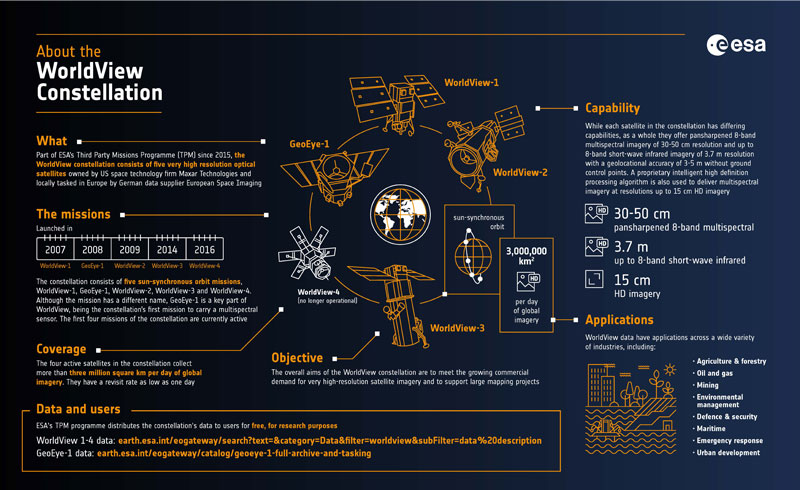- WorldView-2
- Mission
- WorldView-2 Overview
WorldView-2 Overview
Mission Background
Late in 2003, Maxar had received a contract from NGA (National Geospatial-Intelligence Agency) of Washington DC to provide high-resolution imagery from the next-generation commercial imaging satellites. The contract award was made within NGA's NextView programme. The NGA requirements called for imagery with a spatial resolution of 0.5 m panchromatic and 2 m MS (Multispectral) data.
Like its Worldview-1 predecessor, the WorldView-2 spacecraft was manufactured at BATC (Ball Aerospace and Technologies Corporation) which was awarded a contract in late 2006. BATC provided its BCP 5000 (Ball Commercial Platform 5000) spacecraft bus for WorldView-2 and integrated the remote sensing instrument onto the bus - with WorldView-2, a larger imaging payload was mounted onto the same spacecraft bus as that used for WorldView-1. The BCP-5000 bus provides state-of-the-art power, stability, agility, data storage and data transmission (over the BCP-2000 bus).
WorldView-2 was Maxar's third satellite in orbit, joining WorldView-1 which was launched in 2007 and QuickBird which was launched in 2001.
WorldView Infographic
Learn about Maxar's WorldView Constellation, which is part of ESA's Third Party Missions programme:

Satellite Design
The spacecraft is three-axis stabilised. The ADCS (Attitude Determination and Control Subsystem) employs star trackers, SIRUTM (Space Inertial Reference Unit- scalable) of Northrop Grumman, and GPS for attitude sensing, and CMGs as actuators for highly responsive pointing control. A spacecraft body-pointing range of ±40° about nadir is provided corresponding to a FOR (Field of Regard) of 1355 km in cross-track. With its improved agility, WorldView-2 acts like a paintbrush, sweeping back and forth to collect very large areas of multispectral imagery in a single pass. WorldView-2 alone has a collection capacity of 975,000 km2/day.
The combination of WorldView-2's increased agility and high altitude (770 km) enables it to typically revisit any place on Earth in 1.1 days.
| Mass | 2615 kg |
| Dimensions | 5.7 m x 2.5 m |
| Design Lifetime | 12 years |
Mission Operations
WorldView-2 circles Earth in a 770 km, 98 degree Sun-synchronous orbit allowing an average revisit time of just over one day.
The architectural design of WorldView sees customers downloading data from their own ground stations. Amazon Web Services have set up a cloud service for customers to receive data from the Amazon ground station.
Related Links
Learn more about WorldView-2:
*The information provided is sourced and updated by external entities. For further details, please consult our Terms and Conditions page.